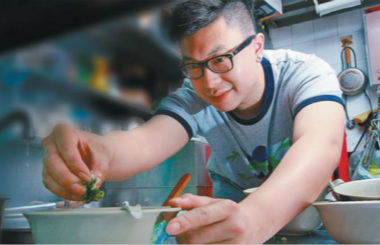Breed-your-own insect 'revolution' for the kitchen
Updated: 2016-01-26 11:04
By Simon Sturdee(Agencies)
|
|||||||||||
 |
|
The UN Food and Agriculture Organization estimates that insects form part of the traditional diets of at least 2 billion people.[Photo/ Agencies] |
A seething mass of larvae in the kitchen is not everyone's cup of tea, particularly for squeamish Westerners. But for two young Austrian entrepreneurs, it's a food revolution that can help save the planet.
Katharina Unger and Julia Kaisinger, 25 and 28, have developed a device to breed in the comfort of your own home the protein-rich grubs of the meal beetle, to then eat.
"With this current design you can make 200-500 grams of mealworms every week," Unger says at a tasting and fundraising event in Vienna.
"You freeze them and then you make them like any other type of meat. You can cook them, roast them, make them into burger patties and mix them into sauce for pasta," she says.
Into the top of the sleek, white "desktop hive" go pupae which then hatch into adults. In the next section, the "loveshack", the insects mate and their eggs fall into the next layer.
Helped by a controlled microclimate, the eggs hatch into larvae which gradually grow and descend to a drawer at the bottom where, around three centimeters long and plump, they are "harvested".
"Our team eats them almost every day," Unger says, showing off some of her creations-Greek salads topped by toasted grubs, quinoa-and-mealworm meatballs and even chocolate (and worm) cake.
Eating insects-entomophagy-is not new. Humans have been doing so for thousands of years and today they are a common food in many developing countries across Asia, Africa, Latin America and Oceania.
The UN Food and Agriculture Organization estimates that insects form part of the traditional diets of at least 2 billion people, with more than 1,900 species reportedly enjoyed worldwide.
In Europe, Romans and ancient Greeks ate them-Aristotle was partial to cicada larvae-and some European cheeses, like mimolette in France or the Sardinian casu marzu, contain or use insects.
Related Stories
Reducing waste can boost food security 2016-01-26 08:09
Tianjin people spend $ 3, 987 per year, food is leading expense 2016-01-25 11:21
South China's food touches the heart 2016-01-22 08:40
Movable food testing vehicle improves Yantai's food safety 2016-01-21 09:14
Gourmet food forges cross-Straits link 2016-01-20 20:37
Today's Top News
China's growth envy of developed world
Foreigners find hard to but China's rail tickets
Rags to riches saga underlines China's transformation
Leaders address Iran's thirst for growth
UK's interest in China boosted by BBC TV series
Global push
AIIB chief vows to run clean, lean, green institution
'More Europe' to deal with 'triple crisis'
Hot Topics
Lunar probe , China growth forecasts, Emission rules get tougher, China seen through 'colored lens', International board,
Editor's Picks

|

|

|

|

|

|






